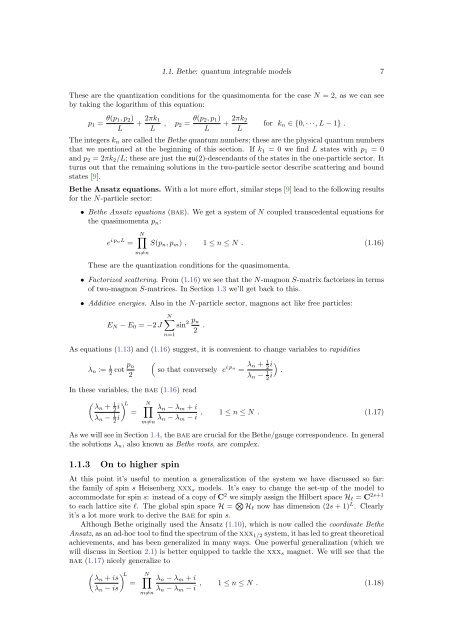The Bethe/Gauge Correspondence
The Bethe/Gauge Correspondence
The Bethe/Gauge Correspondence
Create successful ePaper yourself
Turn your PDF publications into a flip-book with our unique Google optimized e-Paper software.
1.1. <strong>Bethe</strong>: quantum integrable models 7<strong>The</strong>se are the quantization conditions for the quasimomenta for the case N = 2, as we can seeby taking the logarithm of this equation:p 1 = θ(p 1, p 2 )L+ 2πk 1L , p 2 = θ(p 2, p 1 )+ 2πk 2L Lfor k n ∈ {0, · · ·, L − 1} .<strong>The</strong> integers k n are called the <strong>Bethe</strong> quantum numbers; these are the physical quantum numbersthat we mentioned at the beginning of this section. If k 1 = 0 we find L states with p 1 = 0and p 2 = 2πk 2 /L; these are just the su(2)-descendants of the states in the one-particle sector. Itturns out that the remaining solutions in the two-particle sector describe scattering and boundstates [9].<strong>Bethe</strong> Ansatz equations. With a lot more effort, similar steps [9] lead to the following resultsfor the N-particle sector:• <strong>Bethe</strong> Ansatz equations (bae). We get a system of N coupled transcedental equations forthe quasimomenta p n :e i pnL =N∏S(p n , p m ) , 1 ≤ n ≤ N . (1.16)m≠n<strong>The</strong>se are the quantization conditions for the quasimomenta.• Factorized scattering. From (1.16) we see that the N-magnon S-matrix factorizes in termsof two-magnon S-matrices. In Section 1.3 we’ll get back to this.• Additive energies. Also in the N-particle sector, magnons act like free particles:E N − E 0 = −2 JN∑n=1sin 2 p n2 .As equations (1.13) and (1.16) suggest, it is convenient to change variables to rapiditiesλ n := 1 2 cot p n2(so that conversely e i pnIn these variables, the bae (1.16) read= λ n + 1 2 i )λ n − 1 2 i .(λn + 1 2 iλ n − 1 2 i ) L=N∏m≠nλ n − λ m + iλ n − λ m − i , 1 ≤ n ≤ N . (1.17)As we will see in Section 1.4, the bae are crucial for the <strong>Bethe</strong>/gauge correspondence. In generalthe solutions λ n , also known as <strong>Bethe</strong> roots, are complex.1.1.3 On to higher spinAt this point it’s useful to mention a generalization of the system we have discussed so far:the family of spin s Heisenberg xxx s models. It’s easy to change the set-up of the model toaccommodate for spin s: instead of a copy of C 2 we simply assign the Hilbert space H l = C 2s+1to each lattice site l. <strong>The</strong> global spin space H = ⊗ H l now has dimension (2s + 1) L . Clearlyit’s a lot more work to derive the bae for spin s.Although <strong>Bethe</strong> originally used the Ansatz (1.10), which is now called the coordinate <strong>Bethe</strong>Ansatz, as an ad-hoc tool to find the spectrum of the xxx 1/2 system, it has led to great theoreticalachievements, and has been generalized in many ways. One powerful generalization (which wewill discuss in Section 2.1) is better equipped to tackle the xxx s magnet. We will see that thebae (1.17) nicely generalize to( ) L λn + is=λ n − isN∏m≠nλ n − λ m + iλ n − λ m − i , 1 ≤ n ≤ N . (1.18)
















